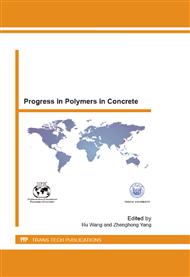[1]
A.E. Naaman, High Performance Fiber Reinforced Cement Composite, Concrete Structures for the future, IABSE Symposium, Paris, France, (1987) 371-376.
Google Scholar
[2]
A.E. Naaman and H.W. Reinhardt, Characterization of High Performance Fiber Reinforced Cement Composites, Proceedings of 2nd International Workshop on HPFRCC, Chapter 41, in High Performance Fiber Reinforced Cement Composites: HPFRCC 2, A.E. Naaman and H.W. Reinhardt, Editors, RILEM, No. 31, E. & FN Spon, London, (1996).
DOI: 10.51202/9783816793977-3
Google Scholar
[3]
Z. S. Metaxa, M. S. Konsta-Gdoutos and S. P. Shah, Crack Free Concrete Made With Nanofiber Reinforcement, (accessed at 1 October 2012), http: /iti. northwestern. edu/publications/utc/safetea-lu/FR-3-Shah.
Google Scholar
[4]
A.E. Naaman, Fiber Reinforced Concrete: State of Progress at the Edge of the New Millennium, Design and Sustainability of Structural Concrete in the Middle East with Emphasis on High- Rise Buildings, Proceedings of the ACI-KC Second International Conference, Kuwait. (2007).
Google Scholar
[5]
B. A. Hamilah, Engineering properties of polymer and natural fiber reinforced mortar, a report submitted in partiall fulfillment of the requirements for the award of the degree of Bachelor of Civil Engineering, (2009).
Google Scholar
[6]
B. Banholzer, Bond of a strand in a cementitious matrix, Materials and Structures 39, (2006) 1015-1028.
DOI: 10.1617/s11527-006-9115-y
Google Scholar
[7]
J.I. Daniel, J.J. Roller and E.D. Anderson, Fiber Reinforced Concrete, Portland Cement Association, Chapter 5, (1998) 22-26.
Google Scholar
[8]
A. E. Naaman, Engineered Steel Fibers with Optimal Properties for einforcement of Cement Composites, Journal of Advanced Concrete Technology 1(3)(2003) 241-252.
DOI: 10.3151/jact.1.241
Google Scholar
[9]
D. J. Kim, S. El-Tawil and A.E. Naaman, Effect of Matrix Strength on Pullout Behavior of HighStrength Deformed Steel Fibers, ACI special publications, sp272, (2007) 135-150.
Google Scholar
[10]
C. Sujivorakul, A.M. Waas, A.E. Naaman, Pullout Response of a Smooth Fiber with End Anchorage, Journal of Engineering Mechanics, American Society of Civil Engineers, 126(9) (2000) 986-993.
DOI: 10.1061/(asce)0733-9399(2000)126:9(986)
Google Scholar
[11]
A.E. Naaman, Fibers with Slip-Hardening Bond, in High Performance Fiber Reinforced Cement Composites-HPFRCC, edited by H.W. Reinhardt and A.E. Naaman, RILEM Publications S.A.R.L., Cachan, France, (1999) 371-385.
DOI: 10.51202/9783816793977-3
Google Scholar
[12]
C. Sujivorakul, Development of High Performance Fiber Reinforced Cement Composites using Twisted Polygonal Steel Fibers, Ph.D. Thesis, University of Michigan, Ann Arbor, (2002).
Google Scholar
[13]
D. J. Kim, , S. El-Tawil and A.E. Naaman, Correlation Between Single Fiber Pullout And Tensile Response Of FRC Composites With High Strength Steel Fibers, ACI Materials Journal 93(5)(1996) 1-7.
Google Scholar
[14]
C. Sujivorakul and A.E. Naaman, Tensile Response of HPFRC Composites using Twisted Polygonal Steel Fibers, Proceedings of Fiber Reinforced Concrete: Innovation for Value, ACI Convention, Toronto, ACI Special Publication, (2003).
DOI: 10.14359/12898
Google Scholar
[15]
Y. Wang, Mechanics of fiber reinforced cementitious composites, PhD thesis, Massachusetts Institute of Technology, (1989).
Google Scholar
[16]
R. Brown, A. Shukla and K.R. Natarajan, Fiber Reinforcement of Concrete Structures, thesis of University of Rhode Island, (2002).
Google Scholar
[17]
D.J. Hannant, Fibre cements and fibre concretes, John Wiley and Sons, New York, (1978).
Google Scholar


